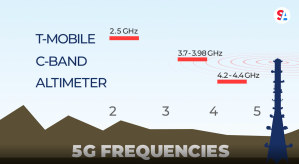After multiple delays over aviation pushback, Verizon Wireless and AT&T finally flipped the switch Wednesday on the new C-band 5G service. But the launch was muddled by eleventh-hour pleas from the airline industry to block 5G near some airports, even requesting presidential interference.
In the end, the wireless companies agreed to temporarily avoid busy runways while the Federal Aviation Administration figures out if 5G signals interfere with plane instruments.
While lower-level 5G service already exists in some parts of the country, the C-band technology Verizon and AT&T were preparing to switch on concerned aviation officials because of how close the frequency is to that used by radio altimeters, a critical tool for pilots to gauge altitude when landing planes in low visibility.

While the mid-band T-Mobile 5G operates at 2.5GHz, U.S. C-band 5G radio waves are between 3.7 and 3.98GHz, much closer to where altimeters operate, at 4.2 to 4.4GHz.
The FAA twice asked the wireless companies to delay the launch before letting it go live January 19, though the companies promised to create a buffer zone around dozens of busy airports for six months.
Just days before the launch, the FAA announced it had cleared nearly half of the U.S. commercial fleet to perform low-visibility landings where C-band is deployed after determining two radio altimeters did not experience interference. Those models, the FAA said, are used in a “wide variety of Boeing and Airbus planes.”
In a statement, the FAA noted that “flights at some airports may still be affected…passengers should check with their airlines if weather is forecast at a destination where 5G interference is possible.”
With the fate of more than half the U.S. commercial fleet still unclear, chief executives at major airlines fought back against the impending launch, warning of “catastrophic” consequences.
In a letter to federal transportation officials written days before the launch, the participating airlines, including Delta, American and Southwest, warned that unless the airlines were cleared to fly, “to be blunt, the nation’s commerce will grind to a halt.”
Airline executives even asked President Joe Biden to intervene. In the end, wireless companies again agreed to delay activating 5G near some airports, putting the blame squarely on FAA for not moving quicker to investigate possible 5G interference.
“At our sole discretion we have voluntarily agreed to temporarily defer turning on a limited number of towers around certain airport runways as we continue to work with the aviation industry and the FAA to provide further information about our 5G deployment, since they have not utilized the two years they’ve had to responsibly plan for this deployment,” AT&T said in a statement the night before the launch.
The companies also argued that 40 other countries with the 5G C-band technology do not seem to have problems with airplanes coexisting.
AT&T and Verizon have been chomping to get C-band deployed. Together they paid the U.S. government $68.8 billion for the spectrum at auction. The wireless speed is expected to be far superior to 4G LTE and existing, lower-band 5G.
For the latest updates on 5G deployment and aviation, visit our developing story here.








